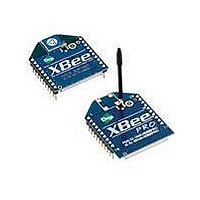XBP24-DMUIT-250 Digi International, XBP24-DMUIT-250 Datasheet - Page 12

XBP24-DMUIT-250
Manufacturer Part Number
XBP24-DMUIT-250
Description
XBEE-PRO MESH 2.4 EXTENDED
Manufacturer
Digi International
Series
XBEE-PRO™r
Specifications of XBP24-DMUIT-250
Frequency
2.4GHz
Data Rate - Maximum
250kbps
Modulation Or Protocol
DSSS
Power - Output
18dBm
Sensitivity
-100dBm
Voltage - Supply
2.8 V ~ 3.4 V
Current - Receiving
55mA
Current - Transmitting
250mA
Data Interface
PCB, Through Hole
Antenna Connector
U.FL
Operating Temperature
-40°C ~ 85°C
Lead Free Status / RoHS Status
Lead free / RoHS Compliant
Package / Case
-
Applications
-
Memory Size
-
Lead Free Status / Rohs Status
Lead free / RoHS Compliant
Other names
Q4197953C
XBee/XBee‐PRO DigiMesh 2.4 RF Modules
Serial Interface Protocols
The XBee modules support both transparent and API (Application Programming Interface) serial interfaces.
When operating in transparent mode, the modules act as a serial line replacement. All UART data received through
the DIN pin is queued up for RF transmission. When RF data is received, the data is sent out through the DOUT pin.
The module configuration parameters are configured using the AT command mode interface.
Data is buffered in the serial receive buffer until one of the following causes the data to be packetized and
transmitted:
API operation is an alternative to transparent operation. The frame-based API extends the level to which a host
application can interact with the networking capabilities of the module. When in API mode, all data entering and
leaving the module is contained in frames that define operations or events within the module.
Transmit Data Frames (received through the DIN pin (pin 3)) include:
Receive Data Frames (sent out the DOUT pin (pin 2)) include:
The API provides alternative means of configuring modules and routing data at the host application layer. A host
application can send data frames to the module that contain address and payload information instead of using com-
mand mode to modify addresses. The module will send data frames to the application containing status packets; as
well as source, and payload information from received data packets.
The API operation option facilitates many operations such as the examples cited below:
The following table compares the advantages of transparent and API modes of operation:
Transparent Operation
API Operation
A Comparison of Transparent and API Operation
• No serial characters are received for the amount of time determined by the RO (Packetization Timeout)
• The Command Mode Sequence (GT + CC + GT) is received. Any character buffered in the serial receive buffer
• The maximum number of characters that will fit in an RF packet is received.
• RF Transmit Data Frame
• Command Frame (equivalent to AT commands)
• RF-received data frame
• Command response
• Event notifications such as reset, associate, disassociate, etc.
• Transmitting data to multiple destinations without entering Command Mode
• Receive success/failure status of each transmitted RF packet
• Identify the source address of each received packet
Simple Interface
Easy to support
Easy to manage data
transmissions to multiple
destinations
Received data frames
indicate the sender's
address
Advanced addressing
support
Advanced networking
diagnostics
Remote Configuration
parameter. If RO = 0, packetization begins when a character is received.
before the sequence is transmitted.
© 2010 Digi International, Inc.
All received serial data is transmitted unless the module is in command mode.
It is easier for an application to support transparent operation and command mode.
Transmitting RF data to multiple remotes only requires changing the address in the API frame. This
process is much faster than in transparent operation where the application must enter AT command
mode, change the address, exit command mode, and then transmit data. Each API transmission
can return a transmit status frame indicating the success or reason for failure.
All received RF data API frames indicate the source address.
API transmit and receive frames can expose addressing fields including source and destination
endpoints, cluster ID and profile ID. This makes it easy to support ZDO commands and public
profile traffic.
API frames can provide indication of IO samples from remote devices, and node identification
messages.
Set / read configuration commands can be sent to remote devices to configure them as needed
using the API.
Transparent Operation Features
API Operation Features
12














